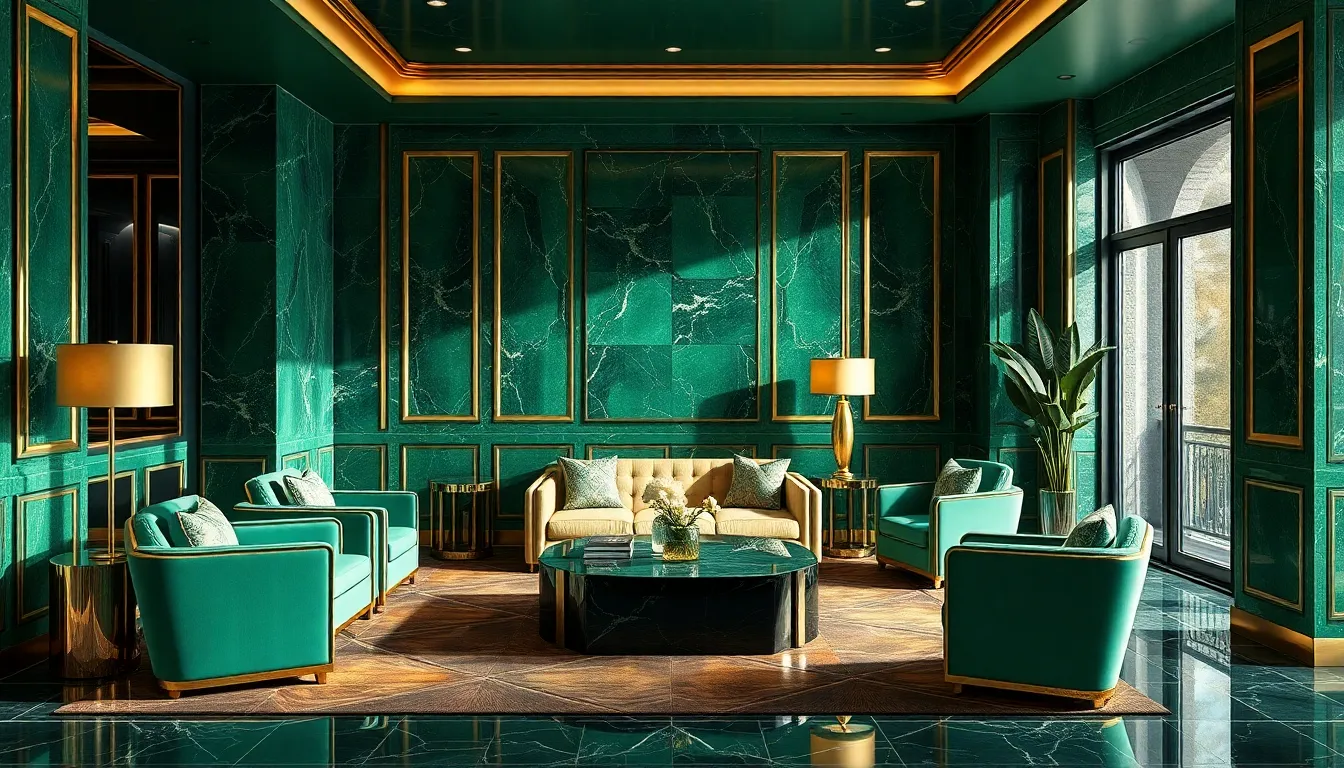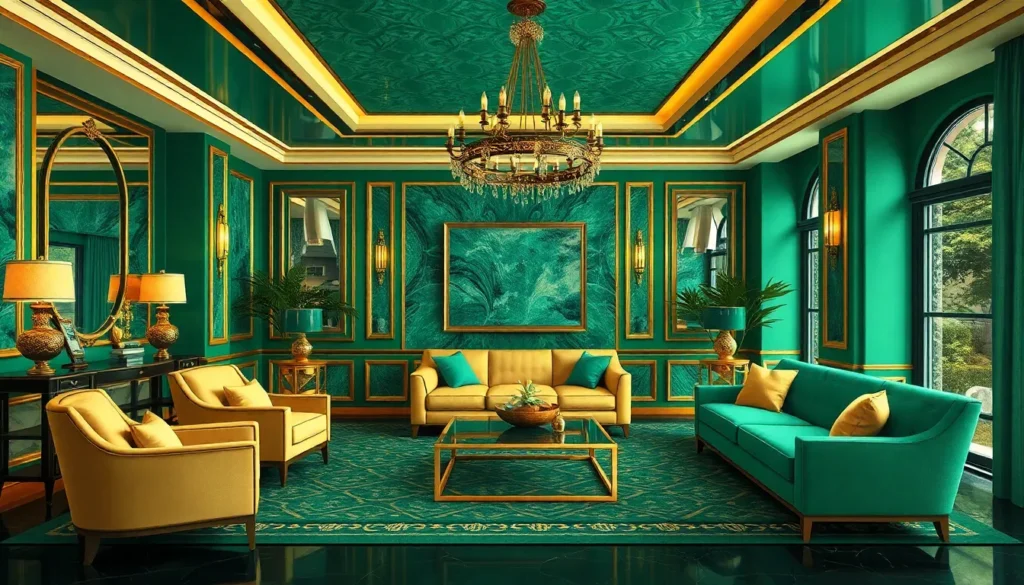Imagine stepping into a world where glamour and sophistication reign supreme. Art deco interiors transport you back to the roaring twenties, blending bold geometric patterns with luxurious materials. It’s like living in a fabulous movie set where every corner whispers tales of elegance and style.
From sleek furniture to dazzling light fixtures, art deco is all about making a statement. It’s the perfect fusion of functionality and flair, ensuring that every space is not just a room but a masterpiece. So, why settle for ordinary when you can embrace the extraordinary? Dive into the captivating realm of art deco interiors and discover how to transform your home into a stylish sanctuary that even Jay Gatsby would envy.
Table of Contents
ToggleOverview of Art Deco Interiors
Art Deco interiors feature bold geometric designs and luxurious materials. Characterized by clean lines and rich colors, this style conveys elegance and sophistication. Elements like chrome finishes and glass give spaces a contemporary feel, while ornate patterns offer a nod to historical influences.
Interior designers often choose vibrant hues such as emerald, gold, and deep blue, which evoke a sense of glamour. Furnishings crafted from exotic woods and high-quality textiles play a crucial role in achieving that aesthetic. Statement pieces, including lavish chandeliers and mirrors, contribute to an irresistible atmosphere.
Incorporating art deco interiors involves thoughtful layering of textures and colors. Wall treatments showcase intricate patterns that draw the eye, while furniture choices provide comfortable yet stylish options. Lighting also plays a significant role, with fixtures designed to reflect the opulence of the era.
Spaces adorned in this style possess a unique ability to blend elegance with functionality. Rather than overwhelming a room, these design elements enhance it, making everyday living luxurious. As a result, art deco influences extend beyond aesthetics, offering a lifestyle that celebrates beauty and artistry.
Art deco styles remain timeless and continue to inspire contemporary designers. Many homeowners appreciate the effort to harmonize nostalgia with modern comfort, showcasing a love for design history. Consequently, art deco interiors attract enthusiasts who seek to elevate their spaces with a touch of historic charm.
Key Characteristics of Art Deco Interiors

Art deco interiors showcase a blend of elegance and bold design choices. This style captures attention with its distinctive features.
Shapes and Lines
Geometric shapes define art deco aesthetics. Streamlined silhouettes feature prominently, enhancing a sense of modernity. Angular forms and symmetrical patterns often dominate furniture and architectural details. Rounded corners appear in some designs, adding softness while maintaining a stylish edge. Curved lines complement sharp angles, creating a balanced visual appeal. Decorative motifs, such as chevrons and zigzags, further emphasize the distinctive shapes found within the style.
Color Palettes
Vibrant color palettes enrich art deco spaces. Emerald green, deep blue, and gold frequently emerge, evoking glamour and sophistication. Neutral tones, such as cream and beige, often serve as backdrops, allowing bold colors to stand out. Contrasting shades create visual interest, encouraging a dynamic atmosphere. Pairing metallic accents with rich hues amplifies the luxurious feel. Monochromatic schemes occasionally appear, unifying a space while highlighting texture and shape.
Materials and Textures
Luxurious materials play a crucial role in art deco interiors. Exotic woods, such as mahogany and walnut, contribute warmth and richness to furniture. Polished marble and granite often grace floors and surfaces, enhancing sophistication. Textiles like velvet and silk add a plush quality, inviting touch and comfort. Mirrored surfaces and chrome finishes reflect light beautifully, intensifying the overall aesthetic. The layering of different textures creates a rich, inviting environment, making every art deco space uniquely captivating.
Historical Context of Art Deco Interiors
Art deco interiors emerged during the early 20th century, flourishing between the 1920s and 1930s, a time marked by economic prosperity and cultural innovation. This period favored luxurious designs that represented progress and modernity.
Origins and Influences
Art deco draws inspiration from various sources, including the 1925 Exposition Internationale des Arts Décoratifs et Industriels Modernes in Paris. Influences from ancient Egyptian, Aztec, and African motifs enrich the aesthetic, merging with modern technology and materials. Industrial advancements in the early 20th century allowed for the use of glass, chrome, and polished metals, reinforcing the opulent character of these interiors. Designers often utilized bold geometric shapes and vibrant colors as well, which contributed to the distinctive look of the style. The result creates an appealing balance between historical references and contemporary sensibilities.
The Evolution of Art Deco Design
Art deco evolved significantly throughout its prominence, reflecting changes in society and tastes. In the 1920s, it showcased exuberance through lavish designs, whereas the 1930s marked a shift toward minimalism and streamlining. Architects and interior designers embraced function alongside form to create spaces that were both beautiful and practical. This adaptability allowed art deco to influence a wide range of environments, from grand hotels to private residences. Crafted pieces exhibited a variety of textures and materials, showcasing the craftsmanship of the era. As tastes continued to change, art deco remained relevant, ultimately merging with modernist elements in later decades.
Notable Art Deco Interior Designers
Art deco interiors owe much of their allure to pioneering designers who shaped the style’s distinctive features. These designers brought innovative approaches and bold aesthetics to their creations.
Famous Designers
René Lalique stands out for his exquisite glasswork and lighting designs that defined the period. Jean-Michel Frank revolutionized luxury interiors with his minimalist yet opulent designs. Elsie de Wolfe, known as America’s first interior designer, utilized art deco elements to create inviting spaces. Meanwhile, Dorothy Draper blended modernism with traditional aesthetics, leaving a lasting impact on hotel interiors. Each designer contributed uniquely, ensuring the lasting legacy of art deco style.
Iconic Art Deco Spaces
The Chrysler Building in New York features iconic interiors that exemplify art deco glamor. The interior of the RKO Roxy Theater showcases stunning detailing and luxurious materials throughout its design. The Miami Beach Architectural District boasts remarkable art deco hotels, where vibrant colors and geometric patterns create a whimsical atmosphere. Another example is the Palais de Tokyo in Paris, which blends contemporary art with art deco influences. These spaces capture the essence of the art deco movement, inspiring modern interpretations.
Incorporating Art Deco Interiors Today
Incorporating art deco interiors today brings a unique flair to modern spaces. This style merges vintage elegance with contemporary design, creating environments that captivate.
Modern Interpretations
Modern interpretations of art deco focus on incorporating its signature elements into current trends. Designers often blend classic geometric shapes with minimalistic aesthetics to create balance. Bold color palettes draw inspiration from the original era, emphasizing rich jewel tones contrasted with muted shades. Natural materials such as marble and brass maintain the opulence associated with art deco while adapting to streamlined contemporary styles. Consider utilizing plush textiles in furniture to evoke luxury while ensuring comfort remains a priority.
Tips for Designing Art Deco Spaces
Designing art deco spaces requires careful consideration of several key aspects. Start with statement furniture pieces that embody streamlined silhouettes and luxurious finishes. Incorporate lighting fixtures that reflect the era’s glamour, such as ornate chandeliers or geometric sconces. Choose rich, saturated colors to set a dramatic tone, using accents to achieve contrast. Introduce artwork or decor featuring intricate patterns to enhance visual interest. Texture plays a vital role; consider mixing smooth surfaces with plush textiles to create depth within the design. Prioritize a cohesive aesthetic, marrying vintage elements with modern conveniences for a balanced space.
Art deco interiors offer a captivating blend of elegance and modernity that continues to inspire design enthusiasts. By embracing bold geometric patterns and luxurious materials, homeowners can transform their spaces into stunning showcases of style. This design aesthetic not only reflects a rich historical context but also adapts seamlessly to contemporary tastes.
Incorporating art deco elements allows for a unique expression of personality while maintaining functionality. With its timeless appeal, art deco remains a favorite among those seeking to elevate their living environments. The allure of this style lies in its ability to create inviting atmospheres that celebrate both nostalgia and modern comfort. Embracing art deco can truly enhance any home, making it a remarkable sanctuary of sophistication.






